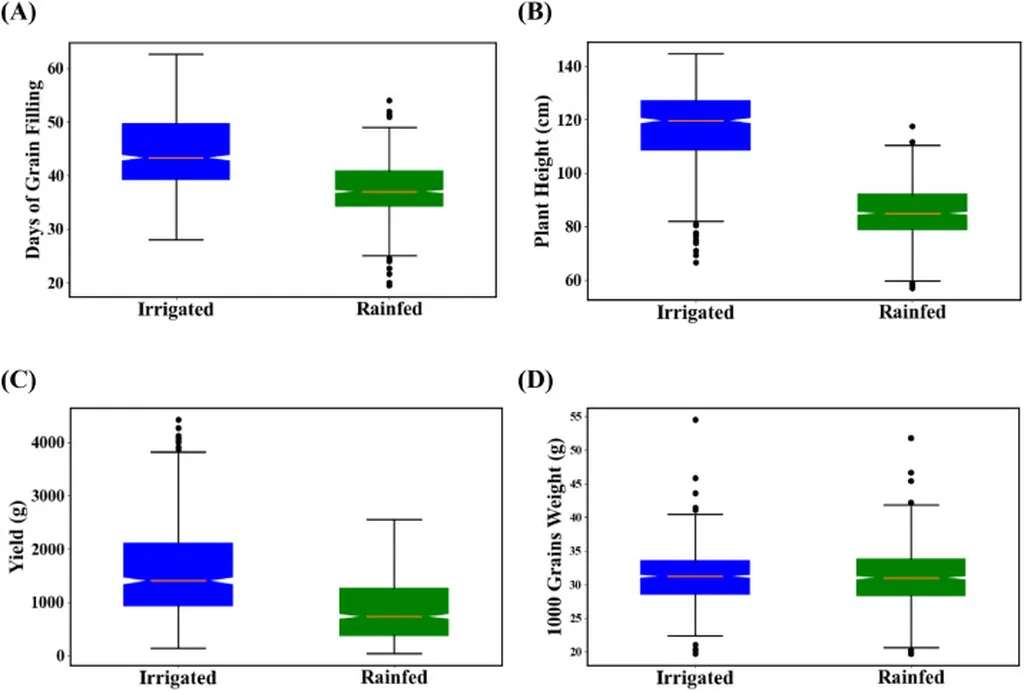In the heart of China, a team of researchers led by Lei Li from the State Key Laboratory of Crop Gene Resources and Breeding at the Chinese Academy of Agricultural Sciences has made a significant stride in wheat breeding technology. Their work, published in the *Crop Journal* (translated from Chinese as “Field Science”), focuses on high-throughput phenotyping to uncover new genetic loci that control the senescence rate in bread wheat. This research could have profound implications for improving wheat yields, particularly in stressed environments, and offers a glimpse into the future of precision agriculture.
The study employed a combination of unmanned aerial vehicles (UAVs) equipped with red–green–blue (RGB) cameras and ground-based SPAD-502 instruments to monitor the senescence process in 262 recombinant inbred lines derived from the cross of Zhongmai 578 and Jimai 22. By assessing chlorophyll content in the flag-leaf over time, the team accurately mimicked the senescence rate, a critical factor in determining wheat yield stability.
“Non-destructive time-series assessment of chlorophyll content in the flag-leaf accurately mimics the senescence rate,” Li explained. “This approach provides valuable knowledge to improve yield stability under stressed environments.”
The researchers quantified the manual senescence rate (MSR) using the flag-leaf chlorophyll and active accumulated temperature, while UAV-derived vegetation indices were utilized to assess the stay-green rate (USG). This dual approach facilitated the identification of both senescent and stay-green lines, offering a comprehensive understanding of the genetic control behind these traits.
The findings revealed that higher senescence rates significantly impacted grain yield, primarily by influencing thousand-kernel weight and plant height. Quantitative trait loci (QTL) mapping for flag-leaf chlorophyll, USG, and MSR using the 50K SNP array identified 38 stable loci associated with RGB-based vegetation indices and senescence-related traits. Notably, 19 loci related to senescence traits from UAV and flag-leaf chlorophyll were consistently detected across at least two growth stages, with nine loci likely representing novel QTL.
“This study highlights the potential of UAV-based high-throughput phenotyping and phenology in identifying critical loci associated with senescence rates in wheat,” Li stated. “It validates the relationship between senescence rates and yield-related traits in wheat, offering valuable opportunities for gene discovery and significant applications in breeding programs.”
The implications of this research extend beyond the field, potentially shaping the future of wheat breeding and agriculture. By identifying key genetic loci associated with senescence, breeders can develop wheat varieties that maintain greener leaves for longer periods, enhancing photosynthesis and ultimately improving yield stability under environmental stress. This could lead to more resilient wheat crops, better adapted to changing climates and varying environmental conditions.
As the global population continues to grow, the demand for food security becomes increasingly critical. Research like this not only advances our understanding of wheat genetics but also paves the way for innovative breeding techniques that can help meet the world’s agricultural challenges. With the findings published in the *Crop Journal*, the scientific community now has a robust framework to build upon, driving further advancements in wheat breeding and precision agriculture.
In the broader context, this research underscores the importance of integrating advanced technologies like UAVs and high-throughput phenotyping into agricultural practices. As these technologies become more accessible and affordable, they could revolutionize the way crops are monitored and improved, leading to more sustainable and productive farming practices. The work of Lei Li and his team serves as a testament to the power of innovation in agriculture, offering a glimpse into a future where technology and genetics converge to create more resilient and productive crops.

